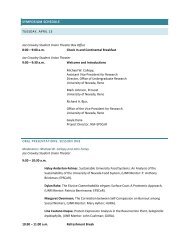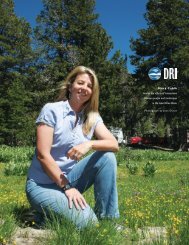Student Research Programs - Office of Undergraduate and ...
Student Research Programs - Office of Undergraduate and ...
Student Research Programs - Office of Undergraduate and ...
Create successful ePaper yourself
Turn your PDF publications into a flip-book with our unique Google optimized e-Paper software.
CONTRALATERAL MIGRATION OF OCULOMOTOR NEURONS IS REGULATED BY SLIT/ROBO SIGNALS<br />
Christine Schlemmer<br />
Program: NIH INBRE<br />
Mentor: Grant Mastick<br />
Department: Biology<br />
University <strong>of</strong> Nevada, Reno<br />
The oculomotor nuclei, located in the ventral embryonic midbrain, are comprised<br />
<strong>of</strong> neurons that innervate the ipsilateral extraocular muscles, <strong>and</strong> the contralateral<br />
dorsal rectus muscle. Correct innervation <strong>of</strong> the extraocular muscles is required to<br />
align the eyes for binocular vision. All oculomotor axons initially extend from the<br />
neural tube on the ventral aspect <strong>of</strong> the cephalic flexure to ipsilateral muscle<br />
targets. However, a subset <strong>of</strong> the neurons that innervate the dorsal rectus muscle<br />
later undertake a unique translocation <strong>of</strong> their cell bodies across the midline,<br />
integrating into the contralateral nucleus. We aim to test the role <strong>of</strong> midline guidance cues in controlling the<br />
contralateral migration. Slit1 <strong>and</strong> 2 are diffusible axon guidance cues expressed at the ventral midline. Robo 1 <strong>and</strong><br />
Robo 2 are known receptors for Slit, <strong>and</strong> axons expressing these receptors are repelled away from the<br />
midline. Previous research shows that Slit/Robo signaling plays a role in neural cell positioning <strong>and</strong> migration<br />
during embryonic development. In Slit mutant mice, the oculomotor nuclei have abnormalities in the axon-like<br />
projections through the midline, <strong>and</strong> were found to migrate across the midline prematurely at embryonic day 11.<br />
Normal migration occurs during embryonic days 13-15. We are testing the hypothesis that oculomotor neurons<br />
express Robo 1 <strong>and</strong> Robo2, <strong>and</strong> that these repellent receptors act to maintain the ipsilateral position <strong>of</strong><br />
oculomotor neurons prior to E13. To characterize Robo expression during migration, cryostat sections were taken<br />
coronal to the cephalic flexure through the oculomotor nuclei. The oculomotor nucleus was identified using<br />
immun<strong>of</strong>louresence for Islet-1, a transcription factor specific for motor neurons. We found Robo 2 co-labels with<br />
Islet-1 prior to migration. Our results suggest that Slit 2 repulsion initially suppresses axonal growth into the<br />
midline, restricting cell bodies to the ipsilateral nucleus. Suppression <strong>of</strong> Slit/Robo signaling allows for migration to<br />
the contralateral nucleus.<br />
PURIFICATION OF PDS5 C-TERMINAL PEPTIDE AND EXPRESSION OF RFP-PDS5 IN DROSPHILA<br />
MELANOGASTER<br />
Alex<strong>and</strong>er Shaft<br />
Program: NIH INBRE<br />
Mentor: Chi-Yun Pai<br />
Department: Biochemistry <strong>and</strong> Molecular Biology<br />
University <strong>of</strong> Nevada, Reno<br />
Pds5 is a nuclear protein that participates in sister chromatid condensation <strong>and</strong><br />
cohesion by interacting with the cohesin complex <strong>and</strong> possibly functioning as a<br />
scaffold for other proteins. We have previously obtained genetic evidence that<br />
Pds5 regulates transcription by interacting with chromatin insulators. In order to<br />
better underst<strong>and</strong> the role <strong>of</strong> Pds5 in transcription, we expressed His-tagged Pds5<br />
in bacteria for antibody production, <strong>and</strong> fluorescent Pds5 in Drosophila<br />
melanogaster to study the dynamic movement <strong>of</strong> the protein. To express 6xHis-<br />
Pds5 in bacteria, a full-length or a truncated cDNA was introduced into E. coli. Purification <strong>of</strong> Pds5 was<br />
successfully accomplished using detergents <strong>and</strong> SDS-PAGE. This purified Pds5 C-terminal peptide will be used for<br />
the production <strong>of</strong> antibodies. For generating Pds5 transgenic flies, the full length Pds5 gene was cloned into P-<br />
21











